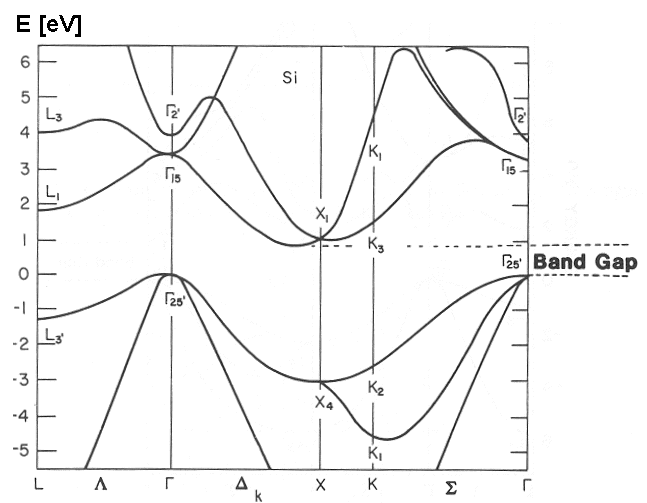Nonequilibrium absorption in bulk silicon: Difference between revisions
mNo edit summary |
|||
| Line 74: | Line 74: | ||
= Renormalization of the exciton binding energy = | = Renormalization of the exciton binding energy = | ||
We finally perform a BSE calculation loading both the nonequilibrium carriers and the quasi-particle energy shifts. | |||
= References = | = References = | ||
Revision as of 14:23, 13 November 2024
In this tutorial you will learn the basic concepts for computing changes in the optical properties of a semi-conductor in presence of a non-equilibrium electrons and holes distribution in conduction and valence band respectively. This tutorial is based on the results published in Phys. Rev. B[1]
Under construction
The material: Silicon
We will study nonequilibrium absorption in bulk silicon. The same material used for this [Silicon|GW tutorial]
- FCC lattice
- Two atoms per cell (8 electrons)
- Lattice constant 10.183 [a.u.]
- Plane waves cutoff 15 Rydberg
- Direct gap 3.4 eV at Gamma
- Indirect gap 1.1 eV between Gamma= (0 0 0) and a point X', close to X=(0 1 0)
Tutorial files and Tutorial structure
Follow the instructions in Tutorials#Files and download/unpack the Silicon.tar.gz.
Once the tutorial archive file is unzipped the following folder structure will appear
COPYING README Silicon/
with the Solid_Si folder containing
> ls Silicon/ PWSCF/ YAMBO/
In the Pwscf folder the student will find an input/output directory with input/output files for pw.x. The Silicon pseudopotential file is also provided.
> ls PWSCF/ convergence_scripts input output psps
In the convergence_scripts you will find some useful shell scripts to run the ground state convergence runs for Silicon.
The YAMBO folder contains the Yambo input/output files and core databases.
> ls YAMBO/ 2x2x2/ 4x4x4/ 6x6x6/ 8x8x8/ Convergence_Plots_and_Scripts/ GAMMA/
The core databases are provided for several k-points grids. In addition the folder Convergence_Plots_and_Scripts contains some scripts used for the [Silicon|GW tutorial] .
Here we will just use the 8x8x8 (which is still very far from convergence) folder for computing (nonequilibrium) optical properties.
To run the tutorial you will need the standard executables
yambo ypp
plus the executables of the real time module of the Yambo code
yambo_rt ypp_rt
Equilibrium optical properties
Enter the folder 8x8x8
> cd 8x8x8
For this step you can either compute static screening at equilibrium, or use the screening computed for the GW step in the Bethe-Salpeter
Static screening at equilibrium
Solving the Bethe-Salpeter equation
Generating non-equilibrium carriers
Energy shift in the band structure
The GW method is the standard approach to compute quasi-particle corrections. However, in presence of non-equilibrium carriers, or even at finite temperature the formulation of the GW self-energy needs to be refined. This is due to its frequency dependence, which results in extra terms when performing the analytic continuation from the Keldish contour (non-equilibrium case) or from the Matsubara axis (finite temperature case) to the real time/frequency axis. See for example this reference [2] for the finite temperature case. On the other hand the COHSEX self-energy, being static, avoids this complication. This is why we will compute changes in the QP corrections within the COHSEX approximation.
COHSEX corrections at equilibrium
Screening in presence of non-equilibrium carriers
COHSEX corrections in presence of non-equilibrium carriers
Renormalization of the exciton binding energy
We finally perform a BSE calculation loading both the nonequilibrium carriers and the quasi-particle energy shifts.
